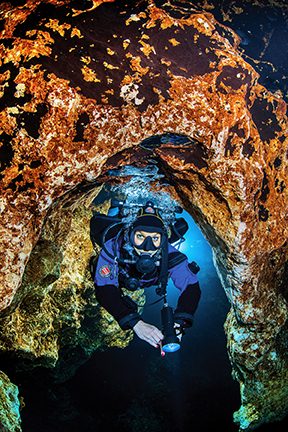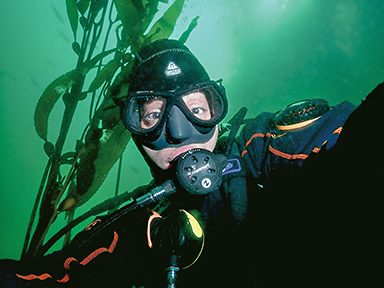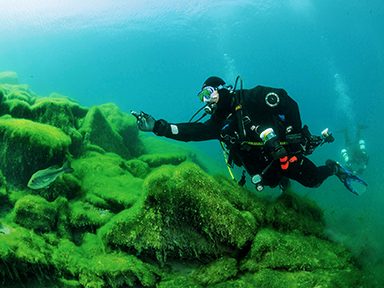MY FACE IS STARTING TO FEEL NUMB, but at least my body and toes are still warm. The way the sunlight dances through the towering kelp is enchanting, and I’m mesmerized by each brown sea nettle I see — their long, corkscrewed tentacles seem to dance in the water like ribbons in a gentle breeze. I can’t believe I finally made the leap, but here I am, diving in California’s Monterey Bay National Marine Sanctuary.
As a tropical diver who has lived in Florida for 10 years, I’ve always been averse to cold water. But after a decade of exploring the underwater realm of subtropical and tropical coral reefs throughout Florida and the Caribbean, I was ready to see what else was out there and expand my dive skill set.
I am a petite woman who wears a 7 mm wetsuit, hood, and gloves during the winter in Florida, so I knew I would need to get certified for drysuit diving for me to dive comfortably any time of year in the colder Pacific Ocean waters. There’s nothing more disappointing than getting halfway through an incredible dive and thinking only about how cold you are. Ending a dive prematurely due to temperature is preventable. Besides, not only did I want to experience diving in kelp forests with colorful anemones and playful sea lions, but I also hoped to eventually explore the cold, fresh waters of the Great Lakes.
In early October 2020 I drove to Blue Grotto Springs in Williston, Florida, for a training weekend. I had the option to get certified at Blue Heron Bridge, my usual dive site in South Florida, but decided that getting a feel for the drysuit in colder conditions would be better. Ocean temperatures around South Florida were still in the low 80s°F (upper 20s°C), but the fresh spring waters in Central Florida are a cool 72°F (22°C) year-round. It was also a chance to explore the limestone (karst) portion of Florida’s aquifer system.
HOW A DRYSUIT WORKS
Many divers opt for drysuits when temperatures are below 60°F (16°C), but people who tend to get cold or are accustomed to tropical conditions may find they are more comfortable in a drysuit in temperatures below 75°F (24°C). Some divers exclusively dive with a drysuit. Ultimately, choosing when to wear one is a matter of personal preferences and comfort.
Wetsuits insulate by trapping a thin layer of water between your body and the wetsuit, while drysuits insulate by trapping a layer of air. The major benefit is that drysuits have seals around the neck and wrist holes, making the suit watertight. The seals prevent cold water from getting into the suit, which keeps your body dry and warm throughout the dive. You can wear warm layers under the drysuit as needed for additional insulation.
Drysuit divers employ a second low-pressure inflator hose that is specifically used for inflating their suit. The air inside a drysuit adds buoyancy, and divers must compensate for that by using more weight than when diving with a wetsuit. As you dive deeper, the air in the suit compresses, which can lead to suit squeeze. To offset that, add small amounts of air to the suit as you descend.
DRYSUIT CERTIFICATION:
WHAT TO EXPECT
The first step in drysuit certification is the knowledge-development course and exam. You will learn about drysuit materials, layering options, getting in and out of the suit with minimal assistance, controlling buoyancy, weighting, and avoiding a feet-first ascent.
Next, you’ll transfer this knowledge to the pool sessions. The essential skills to master are controlling your buoyancy and positioning your body to avoid trapping air in the suit’s lower parts, which could lead to an uncontrolled feet-first ascent. While getting certified, I practiced buoyancy control and body positioning in a pool with my instructor. You want to stay horizontal and should avoid letting your feet go above your body’s midline.
My favorite part was practicing how to recover from a feet-first ascent. The instructor had me inflate my drysuit a bit and start swimming toward the pool bottom. Air got trapped in my boots, and it began lifting me toward the surface. When ascending in this inverted position, it’s impossible to dump the air out of your drysuit because of the position of the dump valves. To overcome this scenario, I learned to curl my knees to my chest, turn my body upright, and use the dump valve to release some air. There are other methods as well; divers should work with their instructors to determine which method works best for them. Getting stuck in a feet-first ascent can be a bit disorienting, and it was a strange feeling the first few times I tried it.

Buoyancy control and body positioning are key elements to successful drysuit diving and are absolutely necessary when navigating overhead environments.
BECKY KAGAN SCHOTT
BLUE GROTTO SPRINGS
We had some chilly, rainy weather during the two open-water dives in the spring at Blue Grotto. I thought the cold was beneficial since I wanted to try multiple dives in colder water and air conditions. The spring water was a bit warmer than the air that day, so a steamy mist rose just above the water’s surface.
On the first dive I was enamored by the beautiful views and crystal-clear water as we made our way to one of the training platforms in the spring’s main area. While practicing the feet-first ascent recovery, some water leaked through the neck and left wrist seals of my drysuit, and from that point on I was cold and uncomfortable.
When we came up for a surface interval and debriefed over a light lunch, I removed the drysuit and saw that my left arm and the front of my body were soaked. After some investigating, it became clear that my drysuit was just a hair too small for me, and the thermal liner was a bit big — the sleeves bunched up at the wrists, and the neckline was too high. The extra material was interfering with the latex seals, so I changed my layers to see if that would make a difference on the second dive.
After entering the water, we swam into the spring’s upper cavern area. (Not all caverns are appropriate for open-water divers, but this one is.) The wide entrance takes you deeper to about 50 feet (15 meters). There is an air bell with viewing windows and breathable air pumped in from the surface. We swam into the air bell, and after having a bit of fun exploring the upper cavern, I tried the skills a few more times. This time I didn’t run into any leaks. I was still a little cold though and knew I would need to buy some warm yet thinner layers for diving in Monterey Bay. It’s critical to pick a comfortable drysuit that fits you correctly and layer appropriately for insulation without adding so much bulk that it interferes with the seals or causes the suit to squeeze in tight areas.

Divers can avoid the need to terminate a dive early due to water temperature concerns by wearing a drysuit.
RACHEL PLUNKETT

Wearing a drysuit allows divers to experience different encounters and a wider variety of freshwater and saltwater environments previously inaccessible to them.
BECKY KAGAN SCHOTT
PRACTICE MAKES PERFECT
After earning my certification, I decided to practice at my local dive site to get comfortable handling the drysuit while carrying my camera and doing underwater photography. It’s a good idea to practice skills between dives to stay fresh and when planning to add a new factor such as handling a camera or other equipment.
MONTEREY BAY
NATIONAL MARINE SANCTUARY
In late October, while visiting a friend in San Francisco, I drove to Monterey for a shore dive along the breakwater at San Carlos Beach with a local dive guide. Despite somewhat hazy conditions, Monterey Bay National Marine Sanctuary greeted me with some excellent macro photography subjects. I saw an orange and white Limacia cockerelli nudibranch, fish-eating and white-spotted rose anemones, and brown sea nettles. We even had an unforgettable encounter with some sea lions that put on a great show when we reached the breakwater’s end. I had never seen kelp in person and felt like an underwater ninja as I maneuvered through the jungle of towering brown stipes and blades.
Not only did I get to observe and photograph marine wildlife I had seen only in magazines and on social media, but I also stayed mostly warm, my suit didn’t leak, and I had a giant smile on my face for the rest of the day.
NEW POSSIBILITIES
FOR ADVENTURE
I plan to return to Monterey Bay and dive at Point Lobos, and I have my heart set on a rugged dive adventure in Channel Islands National Park and Channel Islands National Marine Sanctuary while camping on Santa Cruz Island.
If I’m brave enough to venture into even colder conditions one day, I would like to dive the icy waters of Lake Huron to explore some of the historical shipwrecks such as W.P. Thew, Monohansett, and Grecian. I may even plan a hiking and diving trip in British Columbia, Canada, where I hope to photograph wolf eels and giant Pacific octopus off Vancouver Island.
Expanding my skill set from tropical diving to drysuit and coldwater diving has unlocked so many new opportunities to see habitats, wildlife, geological features, and maritime heritage artifacts that I wouldn’t have been able to access until I took this step. AD
EXPLORE MORE
Learn more more about drysuit diving in this video.